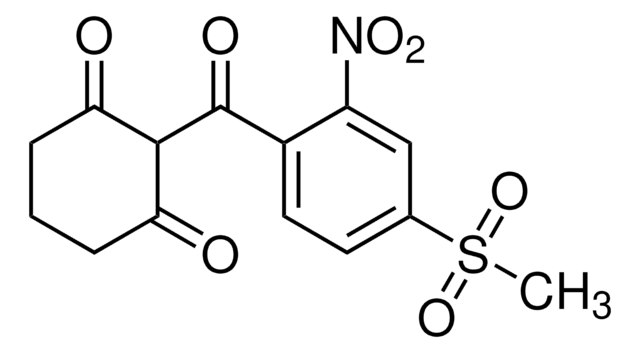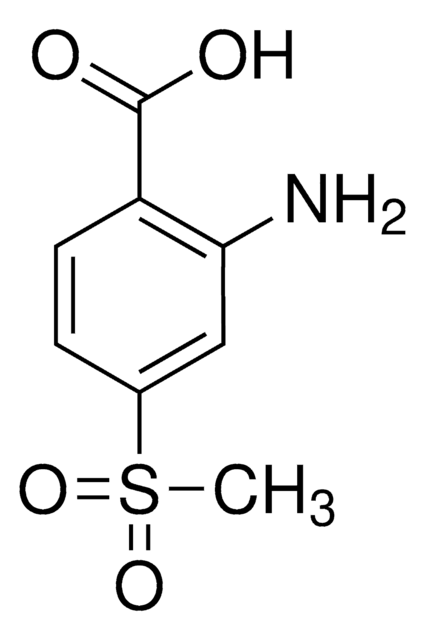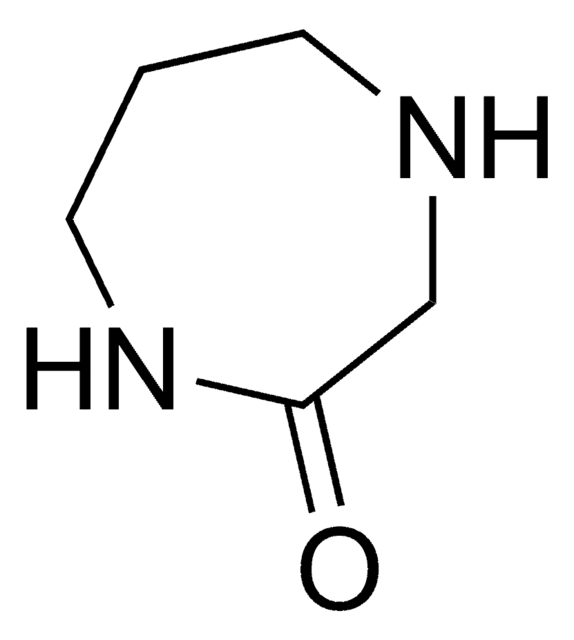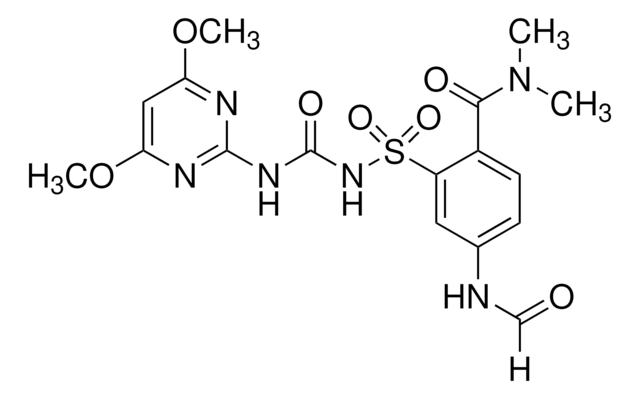CRM18124
Mesotrion Metabolite AMBA
certified reference material, TraceCERT®, Manufactured by: Sigma-Aldrich Production GmbH, Switzerland
Synonym(s):
2-Amino-4-(methylsulfonyl)benzoic acid
About This Item
Recommended Products
grade
certified reference material
TraceCERT®
Quality Level
product line
TraceCERT®
shelf life
limited shelf life, expiry date on the label
manufacturer/tradename
Manufactured by: Sigma-Aldrich Production GmbH, Switzerland
format
neat
storage temp.
−20°C
InChI
1S/C8H9NO4S/c1-14(12,13)5-2-3-6(8(10)11)7(9)4-5/h2-4H,9H2,1H3,(H,10,11)
InChI key
KFOGGDGNOLZBNY-UHFFFAOYSA-N
Looking for similar products? Visit Product Comparison Guide
General description
Certified content by quantitative NMR incl. uncertainty and expiry date are given on the certificate.
Download your certificate at: http://www.sigma-aldrich.com
AMBA (2-amino-4-methylsulfonylbenzoic acid) is one of the metabolites formed from biodegradation of parent Mesotrione. Mesotrione is a selective herbicide that belongs to the triketone family, developed for use in maize culture as a substitute for atrazine. It is used for pre- and post-emergence control of common broad-leaved weeds, primarily in corn (maize). It acts by inhibiting the p-hydroxyphenylpyruvate dioxygenase (HPPD) enzyme, thus, blocking the production of carotenoid pigments in susceptible plants.
Mesotrion is currently approved for its use in the European Union. Maximum residue levels (MRLs) have been set according to Reg (EU) 2017/626 for mesotrione for various products of plant and animal origin from 0.01 to 0.05 mg/kg. Compared to the parent compound, AMBA metabolite is more persistent in soil and possess greater toxicity in selected microorganisms.
Application
- Study the biodegradation and toxicity of herbicide mixtures mesotrione, nicosulfuron, and S-metolachlor by a bacterial strain, Bacillus sp. Mes11
- Isolation and characterization of a Bacillus sp. from cloud water for rapid biotransformation of mesotrione herbicide
- Investigation of mesotrione biodegradation products by the bacterial strain Bacillus sp. 3B6 using liquid chromatography/electrospray ionization quadrupole time-of-flight mass spectrometry (LC/ESI-QTOF-MS)
- Qualitative and quantitative metabolic profiling of mesotrione, by the bacterial strain Bacillus sp. 3B6 using NMR, LC-NMR, and LC-MS
- Method development for the determination of the mesotrione and its two metabolites, MNBA and AMBA in rice, rice plants, rice hulls, water, and soil using UPLC and triple-quadrupole tandem mass spectrometry
Recommended products
Legal Information
Signal Word
Warning
Hazard Statements
Precautionary Statements
Hazard Classifications
Acute Tox. 4 Dermal - Acute Tox. 4 Inhalation - Acute Tox. 4 Oral - Aquatic Chronic 3 - Eye Irrit. 2 - Skin Irrit. 2 - STOT SE 3
Target Organs
Respiratory system
Storage Class Code
11 - Combustible Solids
WGK
WGK 3
Flash Point(F)
Not applicable
Flash Point(C)
Not applicable
Choose from one of the most recent versions:
Certificates of Analysis (COA)
Don't see the Right Version?
If you require a particular version, you can look up a specific certificate by the Lot or Batch number.
Already Own This Product?
Find documentation for the products that you have recently purchased in the Document Library.
Our team of scientists has experience in all areas of research including Life Science, Material Science, Chemical Synthesis, Chromatography, Analytical and many others.
Contact Technical Service








